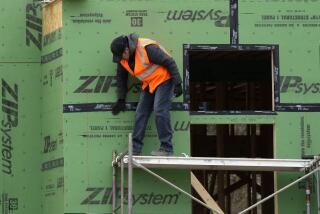Unemployment rate drops in many metro areas
- Share via
Unemployment rates dropped in 281 metro areas throughout the country in October, but many of the areas that performed best were in the Rust Belt, thanks to a manufacturing renaissance.
The region with the largest decrease in the unemployment rate in the country was Muskegon-Norton Shores, Mich., which saw unemployment drop 2.6 percentage points from October 2010 to 9%, according to data from the Bureau of Labor Statistics. Flint and Jackson, Mich., saw significant drops of 2.5% each.
The perennially knocked-about town of Youngstown, Ohio, saw unemployment fall to 8.8% from 10.2% a year earlier, and in the same state, Stubenville’s unemployment stood at 8.9%, down from 10.2%.
“Youngstown in particular, and Ohio in general, are doing substantially better than we were,” said George Zeller, an independent economic research analyst in Ohio. “Auto sales had been picking up, which is where the recovery is coming from.”
Two steel plants are under construction in Youngstown, Zeller noted, and auto parts suppliers across the state are picking up production.
But there may be some signs that growth could slow.
GM’s plant in Lordstown, Ohio, where the Chevrolet Cruze is made, had been booming until the company shut the plant down for a week because of slowing sales. Nationally, new orders in October for all manufactured goods slipped for the second straight month, falling 0.4% to $450 billion. Inventories were the highest since the data started being measured in 1992, indicating the goods have been manufactured but not purchased.
Of all categories, auto inventories grew the most in the month.
“We have been getting a slow recovery, but it is extremely slow,” Zeller said. “And it has been taking a relapse lately.”
Meanwhile, much of the rest of the country remains in an economic torpor. In California, El Centro’s unemployment rate remained among the highest in the nation at 28.9%. The Kennewick-Pasco-Richland area in Washington state saw its unemployment rise 1.7 percentage points to 7.8%.
Even more worrying; benefit checks for nearly 2 million unemployed workers will disappear Dec. 31 if the federal government does not renew its unemployment benefit extensions. Those extensions allow for 34 to 53 weeks of benefits.
The benefits, called Emergency Unemployment Compensation, were enacted in July 2008 and have been renewed nine times. They were last extended in December 2010 through the end of this year.
More to Read
Sign up for Essential California
The most important California stories and recommendations in your inbox every morning.
You may occasionally receive promotional content from the Los Angeles Times.











